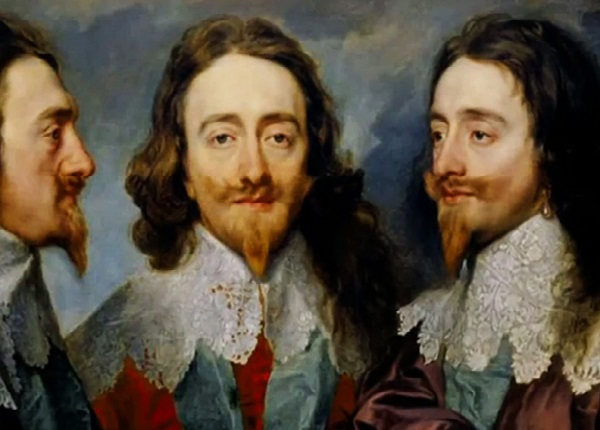
Probably the most famous English monarch after Henry VIII, Charles I was also the most incompetent of the Stuart kings, remembered mostly for triggering a civil war against his own people and, after he was defeated, to be tried and beheaded (the first monarch in Christendom to have that 'honour') by the approval of parliament.

Charles 1 in Three Positions, by Anthony Van Dyck, 1635-6.
Open Family Tree ☰ (Generation 6)
Born in Scotland (the last of the Stuart kings to do so), Charles was the last of James I's children to survive infancy. Like Henry VIII, he was a sickly child and was not expected to survive childhood. That he did was a surprise even to his parents. Neither was he deemed to be promising; short in stature, weak in his legs and slow and stammering in speech. In 1612, however, Henry, the Prince of Wales and his older brother, died and Charles was, officially, restored to the line of succession.
When Charles came to the throne he had the opportunity to make a new beginning of the unhappy reign of his father. Instead he perpetuated the old divisions left behind by his father, and made things worse. For, while James was pragmatic enough to play the game in parliament even though he did not like it, Charles hated and openly disdained it. This was foolish, as only parliament could vote for taxes to be raised, and Charles had inherited a nation that had even less money than when his father came to the throne. And Charles's wars and love for the arts was going to make it poorer still.
From the very beginning of his reign, Charles—though a very decent man at heart—had already made it difficult for the English to like him. Charles, Simon Schama says, "was constitutionally incapable of seeing two (or more) sides to any matter. More seriously for the government of the realm, he was even more incapable of acting against his own decided convictions" (A History of Britian: The British Wars 1603-1776, 68). His marriage to Henriatta Maria (sister of French king, Louis XIII), a staunch Roman Catholic, and the diplomatic and political encumbrances that came with it made England looked like a quasi-Catholic nation rather than the champion of Protestantism, as the Puritans so passionately believed was the nation's calling.
Worse, Charles (far more than his father) held to the concept of divine kingship; that he owed his office as king to God, and is answerable, therefore, only to Him. In 17th Cent Britain this was a recipe for disaster which he managed to avoid more or less for the first fifteen years of his reign. But Charles had fallen in with Bishop William Laud's Arminianism and his High Church love for formalism and rituals which, for many in Britain and, especially, for the Puritans, had all the odour of Roman Catholicism. In 1638 Charles did the very foolish thing of trying to impose Anglican episcopalism on the Church in Scotland (which has long been a Presbyterian stronghold). The attempt provoked a rebellion and then a war when the Scots invaded northern England (what became known as the Bishops' Wars). To prosecute the war with the Scots, however, Charles needed money which only Parliament can approve. In 1640 he called his first parliament. The parliamentarians, however, refused to talk money until their grievances with the king's manner of rule was addressed. Charles, accordingly, cut short the session (hence the name the 'Short Parliament.' It solved nothing for Charles, of course, and within a few months he recalled Parliament. By then the MPs had hardened in their opposition to the king. When the king attempted to arrest some of the leaders of the opposition, they—getting wind of it—made their escape and made a public fool of Charles. Charles then did a most unbelievable thing: he raised his standard of war against his own parliament, and the nation descended into civil war.
The Civil War ended with Charles' defeat—and after a long and difficult debate among the parliamentarians—trial and execution on the cold wintry morning of 30 January 1649. His death was followed by a decade of republican rule, led largely by Oliver Cromwell, before the throne was restored to Charles's son, Charles II.

See also English Civil War
BIBLIOGRAPHY:
Allan Macinnes, Charles I and the Making of the Covenanting Movement 1625-1641. London: John Donald, 1991.
Jane Roberts, The King's Head: Charles I, King and Martyr. London: Royal Collection, 1999.
Conrad Russell, The Fall of the British Monarchies, 1637-1642. Oxford: Clarendon Press, 1995.
Kevin Sharpe, The Personal Rule of Charles I Yale University Press, 1992.
Leanda de Lisle, The White King. Charles I: Traitor, Murderer, Martyr. London: PublicAffairs, 2017.
☰ "The Purtan Conflict," being Sect.92, Chap.VII of Philip Schaff, Creeds of Christendom. Vol. I: The History of Creeds.

©ALBERITH
191111lch